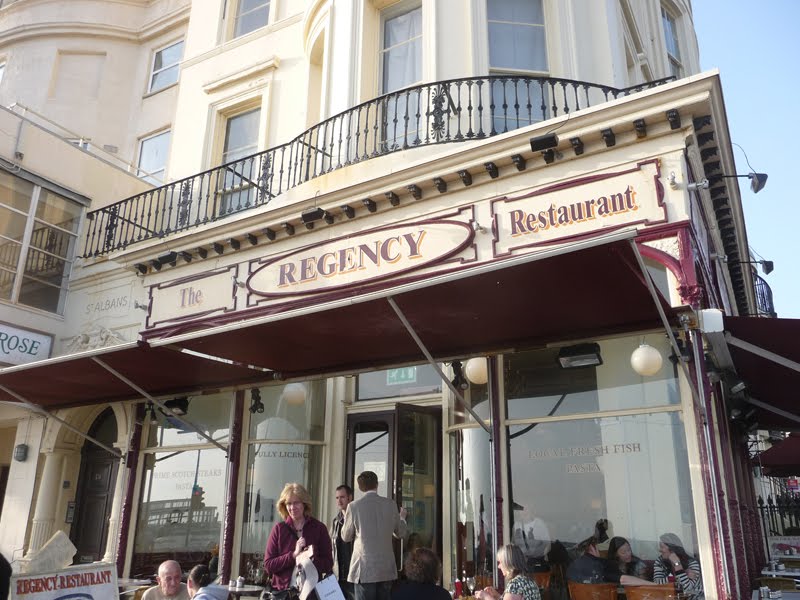Roberto Savvides manages The Regency, a “chippy” (a fish and chip shop) in Brighton (a seaside town in the UK).
Roberto rolls up the sleeves of his crisp white shirt and opens the doors of this modest restaurant for lunch and watches as the customers trickle in. Recently it’s been more than a trickle and he notices that as his restaurant fills up, that the majority of these new customers are Chinese.
Roberto scratches his head, why so many people from China?
So, he asked them.
The answer surprised him and (as his customers explain in the video below) it transpires that if you search for “Best Restaurant Brighton” in Google’s Chinese Mandarin site, his restaurant tops the rankings.
Was this a fiendish SEO plot by some super savvy web developer?
No, it transpires that, unknown to Roberto, a Chinese celebrity chef visited his restaurant, enjoyed his meal and wrote about it in his culinary blog and not only does he feature on Google, but also this has created some buzz on the Chinese social networking site Renren.
“One family from Shanghai came in and said ‘Did you know you’re the most famous seafood restaurant in China?’”
The influx of customers, delivered across thousands of miles through social media is a great story, but there is more to it. It changed the way the restaurant served the food to these new customers. Through talking to them, Roberto discovered that his Chinese guests like all three course delivered at once and they liked to eat quickly.
The upside for the restaurant is that doing it their way not only meant a quicker turn around of tables, but also that they wanted the food together as they like to take photographs of all three course that they then share, helping to further advance the fame of his restaurant.
From a customer engagement perspective, this story clearly demonstrates the value of that advocacy. Someone that thousands of people trust said something good about this restaurant. This became what Seth Godin calls an “idea virus” and all these folks taking photos and uploaded them to social media (in this case Renren) are “sneezing” this idea to their friends.
The result? The Regency became “the most famous seafood restaurant on China”.
An extreme example of the power of advocacy – and a good (if unintended) example of why the contemporary customer engagement — or customer care, or customer experience or even marketing objective — is not just to have someone buy your product, use your services or visit your restaurant, but to create an advocate. And you never know who that advocate may be.
In addition, by adapting the customer experience (the restaurant changed the way they serve this new guest) they created further advocacy by removing friction for new advocates sharing the experience (by being able to photograph all three courses of the food). This great customer experience also provided efficiencies for the restaurant itself, not only in a higher number of customers, but that they are able to turn around the tables faster.
This underlines the view that providing a great customer experience is a fair exchange of value between the customer and the organization providing the service. Without the customer getting value, it’s not a great experience and if the organization doesn’t get value — why will they bother?
So, back to the title of this post, that a modest Brighton “chippy” becomes a global customer experience business – who knew?
This post originally published on Engaging Times.
Fancy more of this?
Subscribe to my Rockstar CMO Newsletter

I’m a 3xCMO, now a marketing strategy advisor and podcast host at Rockstar CMO. Although, I’m not a rock star, but a marketing leader, strategist, content marketer, columnist, speaker, industry watcher, and creator of ART (Awareness, Revenue, and Trust) for the companies I work with. But most of all, I am an enthusiastic tea drinker.
You can find me on LinkedIn, Twitter, or now Threads! – or listen to my weekly podcast at Rockstarcmo.com
The half-baked thoughts shared on this blog may not reflect those of my employer or clients, and if the topic of this article is interesting or you just want to say hello please get in touch.

Hi, I know this is an old article, but I have a case study on this BBC video. So I wanted to know what do you mean by this line:
” they created further advocacy by removing friction for new advocates sharing the experience (by being able to photograph all three courses of the food)”
Question:
What do you mean by friction here? and how do they remove the friction by letting people PHOTOGRAPH all 3 courses of the food ?
Regards,
Mohsin
Hi Moshin,
Apologies for the delay replying to your comment, but like you say this is an older article – but I really appreciate your interest.
My point was that the restaurant adapted the way they served the food to fit the preference of these new consumers – providing a better service experience. A by product of this was that the customers were able to photograph (and share) all of the food together.
For the customer this is an easier social sharing experience (rather than photographing and sharing each plate of food separately).
It was a minor point of the article, but the reference to friction was really about the restaurant making all this easy. Not only serving the customer better, but by doing this they have created a lot of social media attention by making sharing the experience easier – that is further driving the business.
I hope this helps, thanks again.
Ian